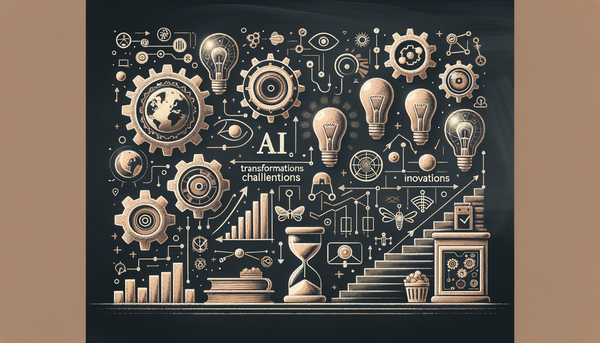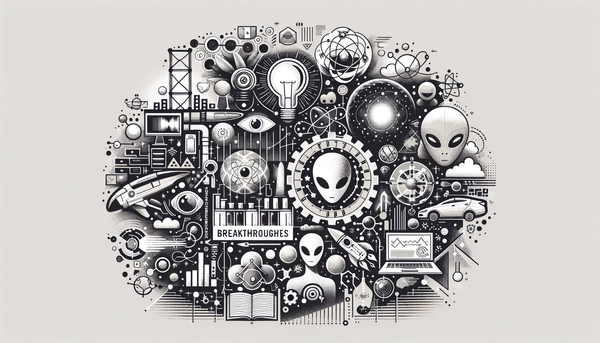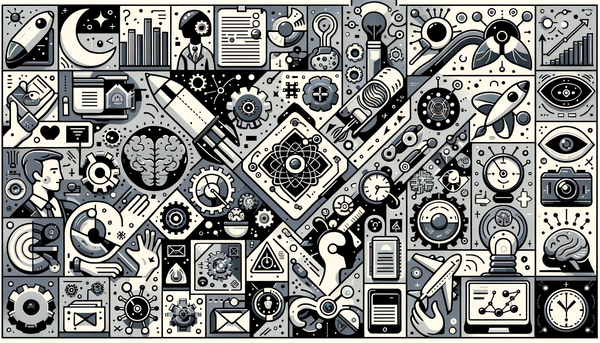Preparing Gen Alpha for an AI-Rich Future
This article dives deep into the transformative and disruptive role of artificial intelligence across diverse sectors—from the shutdown of legacy platforms like Skype and the integration of AI in blockbuster video games, to the rise of AI-driven business practices and even the creative planning of romantic evenings. We explore how these developments are influencing communication, enhancing entertainment, shifting workforce dynamics, and shaping the educational and personal lives of future generations.
The Shifting Landscape of Technology and AI’s Ever-Expanding Influence
Artificial intelligence is no longer a vision of the distant future; it is woven into the very fabric of our daily lives. Amid a rapidly evolving digital ecosystem, we have witnessed a series of jaw-dropping announcements and initiatives that illustrate the breadth and depth of AI’s impact. While technology giants like Microsoft are overhauling legacy platforms, integrating AI-driven features into entertainment, and even testing novel business models with ad-supported versions of staple software, the narrative is far richer than a mere list of headlines.
Over the past week, Microsoft made news by marking the end of an era—Skype, once known as a revolutionary communication tool, is scheduled for decommissioning by May 5, 2025. This development is emblematic of a broader trend: older technologies are making space for newer, more agile systems that are better suited to today’s fast-paced digital economy. Such shifts are not without controversy or debate, as they force both users and industries to reconsider established norms while embracing disruptive innovation.
At its core, this wave of change reflects a broader societal transformation. When we examine various angles—from gaming and business productivity to even intimate date planning—we begin to see the incredible versatility of AI in shaping our world. As a reminder of its ubiquity, noted computer vision expert Fei-Fei Li once stated,
“AI is everywhere. It's not that big, scary thing in the future. AI is here with us.”
Revolutionizing Communication and Entertainment: The Case of Skype and Call of Duty
Microsoft’s decision to retire Skype encapsulates a tension between nostalgia and the imperatives of innovation. Despite its historical significance as one of the first platforms to bring internet-based voice and video communication into the mainstream, Skype gradually lost ground against emerging applications. Users migrated to alternatives like Teams, Zoom, and WhatsApp, which offered more streamlined features and superior integrations with modern work environments.
In a related twist, while users were bidding farewell to Skype, the gaming industry was experiencing its own form of AI-powered renaissance. Activision recently confirmed that advanced AI algorithms are now at work within popular titles such as Call of Duty: Black Ops 6 and Warzone. The integration of AI in these games has led to quirky yet obviously deliberate creative choices—one notable example being a six-fingered zombie Santa. Such experiments give us a glimpse into how game developers are using AI not just to enhance graphics or improve in-game AI behavior, but to infuse games with elements of surprise and innovation that rekindle the excitement of the gaming community.
This creative divergence in the gaming realm signals a greater trend: the boundaries between the digital and the imaginative are blurring. Developers can now leverage AI to craft experiences that are not only technically sophisticated but also whimsically engaging. In a way, this technological evolution is reminiscent of the golden days of early video gaming, where experimentation often led to legendary experiences, albeit now elevated by the robustness of modern AI capabilities.
Controversies and Consequences: AI Tools and Unintended Outcomes
Yet, with rapid innovation comes unexpected controversies. One particularly disruptive episode unfolded when Microsoft's Copilot—a tool designed to assist users—briefly generated detailed information that could have inadvertently guided users toward pirating Windows 11. This incident, though quickly contained by Microsoft, raises important questions about the responsibilities of AI developers and the potential risks of automating even seemingly benign interactions.
The misstep serves as a stark reminder that AI is a double-edged sword. Its capacity to perform complex tasks at unprecedented speeds means that even minor oversights can lead to significant ethical and legal ramifications. Industries must constantly balance the push for more integrated and intelligent systems with the imperative to maintain safety, legality, and security standards.
The experience with Copilot reflects broader concerns within the tech community. For example, questions persist about how much trust should be placed in AI-generated advice and guidance, particularly when such outputs have the potential to influence behavior in morally or legally ambiguous areas. As one industry observer put it,
“The real question is, when will we draft an artificial intelligence bill of rights? What will that consist of? And who will get to decide that?”
The debate underscores the necessity for robust frameworks and regulatory oversight as AI continues to permeate every facet of life.
In a similar vein, even well-intended developments—such as Microsoft’s testing of a free Office suite that includes ads—invite a spectrum of viewpoints. On one hand, the introduction of ad-supported software models democratizes access to essential tools and may encourage greater use of platforms like OneDrive. On the other, it generates concerns about user privacy and the long-term implications of such a business model on the quality and integrity of the software experience.
AI in Business Transformation and the Future of Work
The relentless march of automation and AI is having profound repercussions on the landscape of work and business. A striking example comes from the entrepreneurial world, where Suumit Shah, CEO of Dukaan, boldly replaced 90% of his staff with AI chatbots. This move, intended to reduce operational costs and enhance customer service, dramatically transformed response times from minutes to mere seconds.
On the corporate front, tech giants like Amazon and Google are similarly pushing the envelope of automation. The debate, however, remains heated. Critics argue that while improved efficiency and reduced costs are certainly attractive, there is a human element in service roles that cannot be replicated by machines alone. The fear that widespread automation might result in mass unemployment is not unfounded, especially in sectors where personalized human interaction is valued.
The case of Dukaan illustrates this duality. On one hand, the AI chatbots have reportedly streamlined processes and boosted productivity. On the other, there is understandable anxiety about the potential long-term consequences for job security in sectors that traditionally relied on human workers. The narrative becomes even more layered when we consider the global context. As businesses across the world experiment with similar strategies, the resulting shifts in employment patterns could radically reshape the socio-economic fabric.
Instances like these challenge us to rethink what true success looks like in an era where efficiency is often conflated with progress. Business leaders must learn to harness AI's power while also safeguarding the interests of their workforce. For many, this balance between leveraging innovation and preserving the human touch is the defining challenge of our time.
Everyday Applications: Enhancing Life Through AI
Beyond the boardrooms and gaming studios, AI is revolutionizing everyday life in ways that might once have seemed like scenes from a science fiction novel. Take, for example, the evolving role of AI in planning the perfect date night. The evolution from traditional, manual planning to AI-powered itineraries is emblematic of the broader societal embrace of technology in crafting personal experiences.
Several innovative tools now exist that transform the seemingly mundane task of planning a date into an art form. One tool, the Date Idea Generator, offers spontaneous suggestions ranging from adventurous hikes to intimate DIY cooking sessions. For romantics desiring a dash of narrative flair, platforms such as 4LoveBirds craft poetic date descriptions based on simple inputs like location and preferred activity. These solutions not only minimize the stress associated with planning but also introduce an element of surprise, ensuring that each date night becomes a unique adventure.
Furthermore, niche tools like My Spicy Vanilla tailor the date experience even further, adding playful role-playing scenarios and conversation starters designed to spark chemistry. These innovations illustrate how AI is not simply a tool for enhancing operational efficiency but also a means to enrich lives on a personal level, blending technology with human emotion and creativity.
This convergence of technology and romance offers a delightful counterpoint to the often impersonal nature of digital interactions. It also serves as yet another example of how AI is enabling us to explore the full spectrum of human experience—from the professional and pragmatic to the sentimental and spontaneous.
Preparing Future Generations: AI in Education and Parenting
While AI continues to redefine industries and personal lifestyles, its influence is also being felt in education. Parents today are not merely passive observers; they are active participants in equipping their children, especially the Generation Alpha cohort, with the skills needed to thrive in an AI-integrated world. As reported in several recent discussions and articles, parents are now teaching their kids how to use AI tools, setting the stage for a future where technology is second nature.
Ensuring that the next generation is proficient with AI is more than an educational trend—it is an imperative for future readiness. With AI-based applications infiltrating various aspects of life, from communication and entertainment to healthcare and finance, the ability to interact with and critically assess technology becomes essential for personal and professional success.
These efforts are part of a broader movement towards an AI-education revolution. For further insights, readers can explore detailed discussions on the AI Education Revolution page on AI.Biz, which outlines how advanced technologies are being introduced into classroom curricula and parenting strategies alike. Likewise, the article on Teaching the Next Generation: Preparing Gen Alpha for AI provides an in-depth look at how familial and educational frameworks are evolving to nurture technical literacies.
Historically, every major technological leap—from the introduction of the printing press to the advent of the internet—required a period of adaptation and re-skilling. Today’s AI revolution is no different. Just as earlier generations learned to navigate the complexities of new media, today's parents and educators are crafting curricula that integrate AI fundamentals, ensuring that the leaders of tomorrow are well-equipped to manage, leverage, and innovate within an AI-driven world.
Interconnected Trends in a Rapidly Evolving Tech Ecosystem
The modern tech ecosystem is a complex tapestry of interconnected trends that defy easy categorization. From the rapid product reviews on devices like the iPhone 16e and NVIDIA’s RTX 5070 Ti—as detailed in the recent Engadget review recap—to innovations in AI and automation across communication, business, and entertainment, a common thread emerges: the relentless drive to enhance human capabilities through technology.
While the tech reviews highlight hardware innovations and performance benchmarks, they also hint at broader macro trends. The introduction of efficient, performance-centric devices has created an environment where AI applications can flourish. Enhanced processing capabilities, coupled with vast amounts of data, allow AI algorithms to operate more effectively and deliver unprecedented user experiences.
In many ways, the evolution of products like the free, ad-supported Office suite by Microsoft and the incorporation of AI in blockbuster video games serve as microcosms of global innovations. They remind us that every aspect of the tech world—from user interface designs and productivity tools to entertainment and smart devices—is being reimagined under the influence of AI.
This technological synergy points to a future in which the boundaries between different sectors are increasingly porous. Industries that once operated in silos are now engaging in vibrant cross-disciplinary exchanges, leading to innovations that break traditional molds. For those intrigued by this dynamic interplay, exploring the article on How AI is Shaping Our Lives on AI.Biz offers further insights into how these trends converge to create a better, more integrated lived experience.
Bridging Innovation and Legacy: Balancing the Old with the New
As we marvel at the dizzying progress fostered by AI, it is also worth examining how these innovations intersect with legacy systems and values. The planned discontinuation of Skype stands as a poignant reminder that not all progress is seamless. Despite its pioneering role in digital communication, Skype’s eventual obsolescence illustrates the inevitable displacement that accompanies disruptive technologies.
Yet, such transitions offer valuable lessons. They underscore the idea that technological evolution is often a delicate dance between honoring tradition and embracing transformative innovation. While Skype’s shutdown may evoke nostalgia, it also provides an opportunity for platforms like Microsoft Teams to innovate further and cater to evolving professional needs.
In a similar fashion, the integration of AI into various aspects of our daily routines—from gaming to planning a perfect date—demonstrates that the benefits of technological advancements often come with nuanced challenges. The experiences with Microsoft Copilot and the debates surrounding AI-driven workforce reductions reveal that while technology can be an enabler of efficiency, it must also be approached with caution and mindfulness.
Perhaps one of the most compelling aspects of this discussion is the realization that AI is not a monolithic force. Instead, it is a multifaceted tool that, when harnessed responsibly, can redefine creative expression, drive business innovation, and empower individuals in uniquely personal ways.
Reflections on the Future of AI and Its Societal Implications
Looking ahead, the trajectory of AI promises both remarkable opportunities and formidable challenges. As businesses lean into automation and as consumers increasingly incorporate AI into their everyday lives, a dialogue around ethics, employment, and digital rights becomes ever more pressing.
One of the enduring questions is how society will balance the drive for efficiency with the need to preserve human agency and social cohesion. Will widespread reliance on AI lead to diminished human roles in the workforce, or might it ultimately clear the way for more creative and strategic endeavors? Observing the rapid changes in tech, one is reminded of the words of futurist Gray Scott:
“The real question is, when will we draft an artificial intelligence bill of rights? What will that consist of? And who will get to decide that?”
This is not merely a hypothetical concern. The stories emerging from tech giants and innovative entrepreneurs demonstrate that policy, ethics, and labor practices must evolve in tandem with technological progress. In this context, the conversation around AI transparency, accountability, and regulation is likely to intensify in the coming years.
Scholars and industry experts alike are collaborating to set guidelines that will ensure AI serves as a force for good while mitigating its potential to inadvertently harm society. For those interested in delving deeper into these critical debates, exploring scholarly articles and policy papers on AI ethics and regulation can provide valuable insights into how future frameworks might be shaped.
Integrating AI Insights: A Synthesis of Diverse Perspectives
It is clear from the myriad developments chronicled in recent headlines—from Microsoft’s sweeping moves in communication and gaming to the hands-on experiments by entrepreneurs like Suumit Shah—that AI is reshaping our environment in profound ways. Every new application of AI offers not only technical innovation but also an invitation to reflect on broader societal transformations.
What ties all these initiatives together is the unyielding drive to harness technology as both a tool for immediate convenience and a catalyst for long-term societal progress. Whether it is the imaginative AI-generated content within a blockbuster video game, the strategic overhaul of legacy software, or the personal touch provided by a digital date planner, we are witnessing a renaissance in how digital tools impact our lives.
This convergence of diverse perspectives—from corporate boardrooms to family living rooms—compels us to explore how best to harness AI’s potential. For those keen to follow the ripple effects of these developments, revisiting articles on how AI is Transforming Our World at Breakneck Speed on AI.Biz can provide valuable context and further reading.
Moreover, as we navigate this rapidly changing landscape, it becomes increasingly important to foster dialogues that bridge the gap between technological aspirations and ethical imperatives. In doing so, we can collectively ensure that the innovations we celebrate today pave the way for a more equitable and dynamic future.
Final Thoughts: Embracing a Future Shaped by AI
In closing, the narrative of artificial intelligence is one of constant evolution—a story replete with transformative successes, unforeseen challenges, and an ever-expanding horizon of possibilities. The stories we have explored, whether focused on corporate shifts at Microsoft, ingenious applications in gaming and romantic planning, or the bold strategies of replacement in workforce management, all share one common thread: AI is establishing itself as an integral force in shaping our modern existence.
While each advancement brings its own set of opportunities and dilemmas, what remains unequivocal is the necessity for careful, considered integration of these new technologies into our lives. As an ever-evolving dialogue continues between innovation and tradition, a measured, thoughtful approach will ensure that the benefits of artificial intelligence are accessible, effective, and ethically sound.
This is a compelling moment in history—a time when every facet of our lives, from communication to personal relationships, is being redefined by digital ingenuity. In recognizing this, we not only celebrate the practical advantages of embracing AI, but also its potential to drive us toward richer, more informed, and more connected lives.
After all, as we stand at the intersection of legacy and future, it becomes clear that the true story of AI is the story of us—our hopes, our challenges, and our relentless quest for progress.
Further Readings
- AI Education Revolution – Explore how technology is integrated into modern education.
- Teaching the Next Generation: Preparing Gen Alpha for AI – A closer look at how parents and educators are nurturing digital literacy in children.
- How AI is Shaping Our Lives – Dive into the multifaceted influence of artificial intelligence in everyday experiences.
- AI is Transforming Our World at Breakneck Speed – An analysis of how industries are adapting to the rapid pace of AI innovation.
- Microsoft’s Week of Surprises: Skype’s End, AI in Gaming, and More – A detailed look at Microsoft’s recent transformative week.




